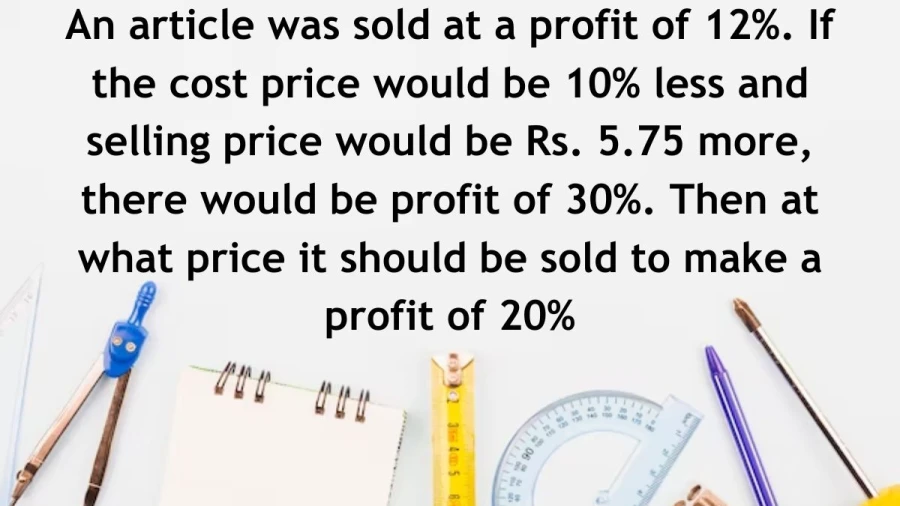If you happen to be viewing the article An article was sold at a profit of 12%. If the cost price would be 10% less and selling price would be Rs. 5.75 more, there would be profit of 30%. Then at what price it should be sold to make a profit of 20%? ? on the website Math Hello Kitty, there are a couple of convenient ways for you to navigate through the content. You have the option to simply scroll down and leisurely read each section at your own pace. Alternatively, if you’re in a rush or looking for specific information, you can swiftly click on the table of contents provided. This will instantly direct you to the exact section that contains the information you need most urgently.
An article was sold at a profit of 12%. If the cost price would be 10% less and selling price would be Rs. 5.75 more, there would be profit of 30%. Then at what price it should be sold to make a profit of 20%?
The article should be sold at Rs. 138 to make a profit of 20%.
Let the cost price of the article be Rs. x.
Scenario 1: Actual Sale
- Selling price (SP1) = Rs. (x + 12% of x) = Rs. 1.12x (Profit of 12%)
Scenario 2: Hypothetical Sale with Lower Cost Price and Higher Selling Price
- New Cost Price (CP2) = Rs. (x – 10% of x) = Rs. 0.9x (10% less than original CP)
- New Selling Price (SP2) = Rs. (1.12x + 5.75) (Rs. 5.75 more than original SP)
- Profit in Scenario 2 = 30%
Relating the Scenarios:
We know that profit in Scenario 2 is 30%. We can express this as:
(SP2 – CP2) / CP2 = 30/100
Substituting the expressions for CP2 and SP2:
[(1.12x + 5.75) – 0.9x] / 0.9x = 30/100
Simplifying the equation:
0.22x + 5.75 = 0.27x
Solving for x (cost price):
0.05x = 5.75
x = 115
Scenario 3: Selling Price for 20% Profit
We now know the actual cost price (x = Rs. 115). To achieve a 20% profit, the selling price (SP3) needs to be:
SP3 = CP3 + 20% of CP3
SP3 = 115 + (20/100) * 115
SP3 = Rs. 138
Therefore, the article should be sold at Rs. 138 to make a profit of 20%.
How to Calculate Profit Percentage?
To calculate the profit percentage, you need to know the profit and the cost price of an item. Once you have those two values, you can use the following formula:
Article continues below advertisement
Article continues below advertisement
Profit Percentage = (Profit / Cost Price) * 100%
Here’s a step-by-step guide on how to calculate the profit percentage:
- Determine the cost price (CP) of the item. This is the amount of money you spent to acquire or produce the item.
- Determine the selling price (SP) of the item. This is the amount of money for which you sold the item.
- Calculate the profit (P) by subtracting the cost price from the selling price: Profit = SP – CP.
- Use the profit and the cost price to calculate the profit percentage using the formula mentioned above.
Here’s an example:
Let’s say you bought an item for $50 and sold it for $80.
- Cost Price (CP) = $50
- Selling Price (SP) = $80
- Profit (P) = SP – CP = $80 – $50 = $30
- Profit Percentage = (Profit / Cost Price) * 100% = ($30 / $50) * 100% = 0.6 * 100% = 60%
So, the profit percentage in this example is 60%.
Thank you so much for taking the time to read the article titled An article was sold at a profit of 12%. If the cost price would be 10% less and selling price would be Rs. 5.75 more, there would be profit of 30%. Then at what price it should be sold to make a profit of 20%? written by Math Hello Kitty. Your support means a lot to us! We are glad that you found this article useful. If you have any feedback or thoughts, we would love to hear from you. Don’t forget to leave a comment and review on our website to help introduce it to others. Once again, we sincerely appreciate your support and thank you for being a valued reader!
Source: Math Hello Kitty
Categories: Math

